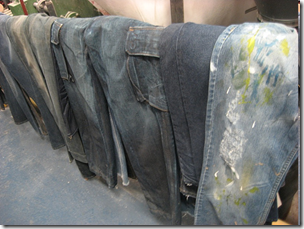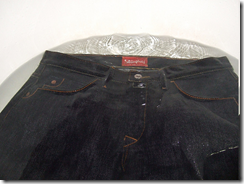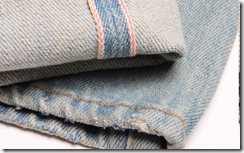Fashion is today incomplete without denim. Denim comes in all forms, looks and washes to match with every dress . It would be difficult to believe that the same denim was originally employed in clothing for the pants and overalls worn by miners on the west coast(US). A number of technological factors have contributed to making denim the fashion icon that it is today – including vast improvements in spinning, weaving, finishing etc. One of the most important part of creation of the beautiful denim jeans is the washing . Washing plays such an important part in the denim chain because of the umpteen effects that the consumers are looking for on their jeans . Lets talk a bit about denim washing …
BASIC DENIM WASHING PRINCIPLES
Below is the brief introduction to common steps done & followed in denim garments washing in Laundries across the world. Different kind & make of machines being used across the globe to hit similar results.
Every small step in denim washing makes a big difference because indigo dye has very poor wet & dry rubbing fastness. All parameters are critical to maintain for repetitive results. Eg Many laundries across the Globe ignore the importance of pH M:L:R & R P M of machine.
Some important steps in the process of Denim Washing
- Pre treatment ( Desizing, Rinsing, Scouring etc)
- Enzyme or Stone wash
- Clean up to adjust the desire effect
- Bleaching
- Tinting / Dyeing
- Softening & Much more…..
1.PRE TREATEMENT
This is very first & basic step but most important step of washing. Here the fate of denim garment is decided that its going to appear good or bad. Good Pre treatments avoid streaking, stiffness & color loss. This process removes impurities, starch & stains during handling of fabric.
This step is also called desizing ( Removal of Size applied during denim fabric making in weft yarn ). All the woven fabric contains size on them due to reasons to strengthen the yarn for weaving.There are many types of sizes available in the market but they can be divided in two major groups.
- Water Soluble (CMC or PVA based sizes ) and
- Dissolvable sizes in water ( Starch based ). Starch based sizes are most commonly used due to cheap prices & readily availability.
Methods of Removing Sizes from Denim Jeans……
· Washing with High Alkaline agents ( i.e. Soda ash )
· Washing with High Acidic agents (i.e. Acetic acid )
· Washing with Oxidative chemicals ( i.e. Hydrogen Peroxide )
· Enzymatic desizing with Alfa amylase .. This is eco friendly & convenient .
2.Enzyme & Stone Washing Process Of Denim Garments
There are four kind of Enzymes available in market for Denim Laundry business..
- Amylase …. Desizing
- Cellulase …. For Salt & pepper effect , contrast
- Laccase…. … bio bleaching
- Catalase …… Peroxide killer
Enzyme is kind of protein that is obtained from fermentations method from naturally existing bacteria & fungi. The structure of Enzyme is a biological polymer and it can be found in every cell. Generally called as Cellulase & it works on cotton( Cellulosic fiber ) only. Enzyme are living organisms which will attack a specific molecular group.
There are mainly three kind of Cellulase being used for Denim washing , Neutral, Acid and Bio polishing Enzyme. Enzyme are very sensitive with parameters in washing cycle i.e, pH , Temperature & time. If any of these parameters are not up to the mark, result will not be accurate.
The reaction of enzyme can be easily controlled, its biodegradable products, so they eco friendly.
Bio Polishing Cellulase are being used to have protruded fiber removal from denim & oven fabric. This is also widely known as Anti pilling enzyme.
Any Cellulase used in process must be cleaned/killed after the process completion by simply disturbing the parameters ie. By raising high temp. or raising pH to alkaline where no Cellulase withstand.
Cellulase are available in 3 categories
Neutral
Acidic &
Hybrid enzymes.
Neutral enzyme gives better salt & pepper effect with very less back staining & its generally come sin powder form & also retains better strength of fabric than acidic Cellulase. Where as acidic cellulase give faster results but with too heavy back staining & cuts down the indigo color, also affects the strength of fabrics.
Now a days laundry people needs faster results in less time & money hence chemical suppliers combined Neutral & acid cellulase in such way that it works faster & with better results than acid cellulase with cost effectiveness & known as Hybrid enzyme.
Laccase is bio bleaching agent & alternative for conventional bleaching agents. This impart greyer cast to blue denim & enhances salt & pepper effect. But due to high cost & low self life, laundries do not prefer it.
3.CLEAN UP
After finishing Enzyme wash it is must to add clean up process for better results & garments appearance & that can be done in various ways & methods. As clean up is a must process to be carried out after every chemicals steps done for any garments which allows next process to happen smoothly. All processes mentioned below kill/ deactivate the active enzymes process which is necessary in order to protect/retain garment strength……
- a.Hydrogen peroxide in alkaline pH clean up enhances the brightness & rich blue tone of indigo.
- b.By using non ionic detergents in medium to high temperature
- c.By doing two good hot water rinse etc….
4.BLEACHING
This in one an important step in washing denim & can be done by various bleaching agents …..
- a.Calcium hypo chlorite
- b.Sodium hypo chlorite
- c.Hydrogen peroxide
- d.Potassium permanganate
First two chemicals are commonly being used for every medium to vintage denim but when it comes to super vintage & light shade its advisable to use potassium permanganate bleach to cut the color faster till half way & then neutralize it & go with Liquid ( Hypo ) bleach to adjust the desired shade. This process helps to get Greyer cast & also protects the lycra/spandex , retain elasticity.
Hydrogen Peroxide is rarely used as bleaching agent when very less color loss required or if fabric is sulphur top. As it takes longer time to give desired effect.
Potassium Permanganate is also being used on 100% sulphur black denim fabric for bleaching/reducing agent to get unique effects. As its not production friendly till laundry have very expertise team to handle this program, otherwise it will result in many shades & cast.
Proper Neutralizations of bleaching process is very essential in order to get rid of fabric strength , bad smell from garment, yellowing & skin irritation etc…
4.Tinting & Dyeing
Tinting is a process where very less amount of tint is involved & mainly direct dye is being used to do this process. This is being done to change hue/cast/tone of indigo. As soon as quantity of tint color increases & it cover up indigo, reaches the level of dyeing.
Tinting being used to give garments a used / vintage & muddy look. This process takes from 5 minutes to 15 minutes time for better results followed by dye fixing & clean up of superficial dye.
Dyeing is being done on very light shade of Indigo, Ecru/ grey denim & Ready for dyeing denim.
• There are various Types Of Dye . THe comparison of these dyes is given in the chart herebelow:
1-Direct Dyes
2-Reactive Dyes
3-Pigment Dyes
4-Sulphur Dyes
| Direct Dyes | Reactive Dyes | Pigment Dyes | Sulphur Dyes |
|
Economical |
Costly |
Cost Efficient |
Economical |
|
Wide range of shades |
Wide range of shades |
Styling ( limited to dull shades) |
Shades are dull |
|
Short Cycles |
Long Cycle |
Short to long Cycle |
Short to long Cycle, depends upon shade |
|
Ease of application |
Water Consumption High |
Machine contamination, but hard to obtain consistency, harsh hand feel |
Sulphur Odour & harsh hand feel |
|
Smooth Appearance |
Smooth Appearance |
Smooth Appearance |
Smooth Appearance |
5.SOFTENING PROCESS
Softening process of Denim is very critical. As denim is very heavy in compare with other fabrics hence its needs softening. During this process there is a big problem -the discoloration of denim i.e change in shade or loss of whiteness, giving a yellow tint is commonly known as yellowing. By using normal softener will lead to ozone problem. Indigo dyed fabric are even more prone to yellowing.
As it’s a widespread problem & there in no single reason for its cause. Instead a number of condition can singly or in combination lead to the problem. Yellowing in not specific to certain fibers, finishes or washing processes. It is not specific to chemicals or chemical treatment but certainly some of the factors among these can lead to the yellowing. As cotton & all organic polymers develop yellowing in time.
Light , acids, impurities, detergents & chemical contribute to yellowing problems.
Temperature of drying & curing can impart yellowing due to scorching of the cotton. Therefore good control must be used to minimize this type of damage.
Hence its advisable to use Antiozonate softener which prolong ozone reaction of Indigo & keep garment in good condition.
MINIMISATION OF YELLOWING RISK:
Its Impossible to eliminate yellowing but it is possible to prolong & reduce the conditions which causes classical yellowing:
· Ensure bleaching neutralization & rinsing is proper
· Minimize back staining
· Avoid use of chemicals which cause yellowing
· Avoid leaving garment in open air for longer time
· Control drying & curing temperatures
· Using right Antiozonate softener with right pH





